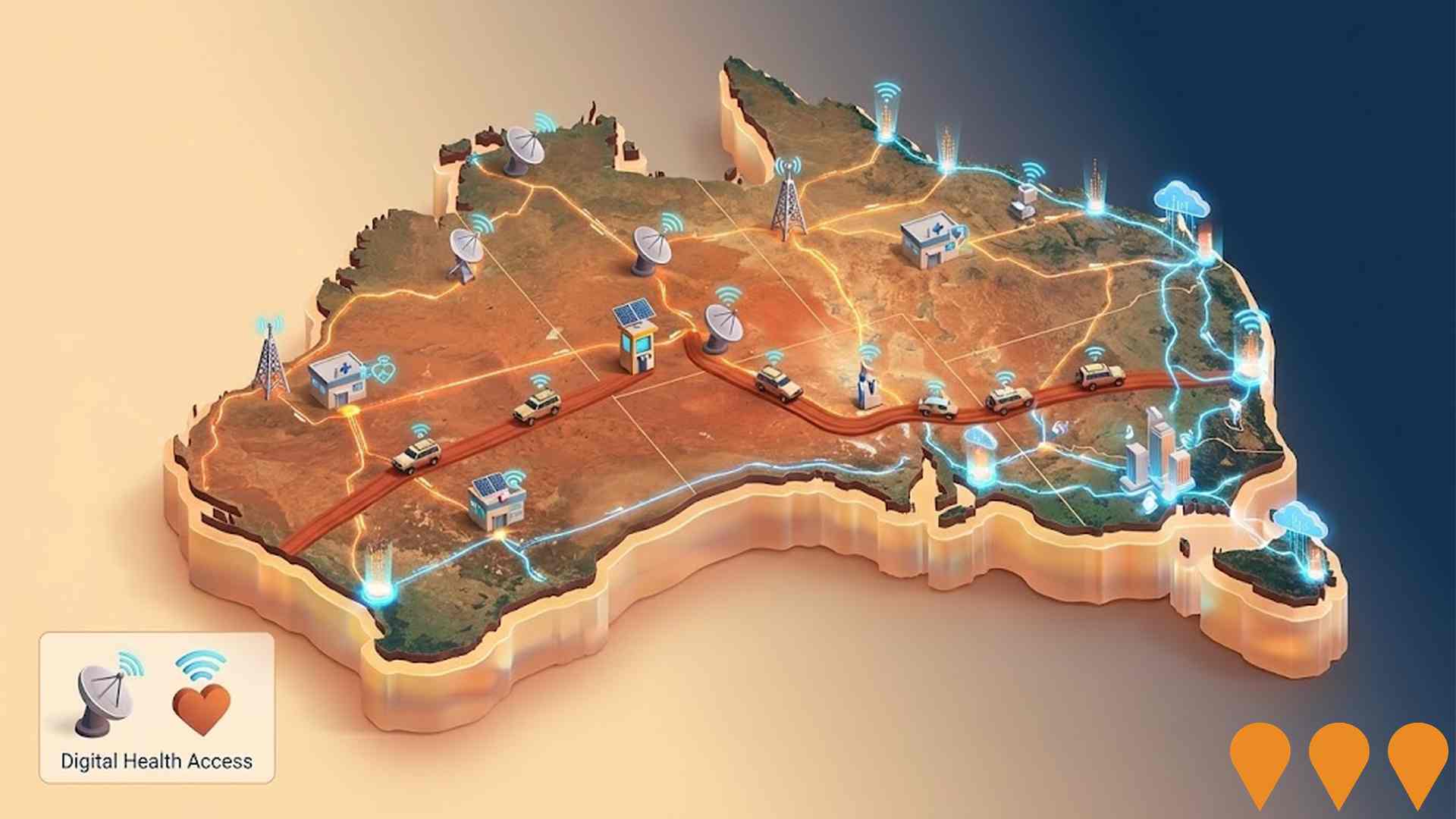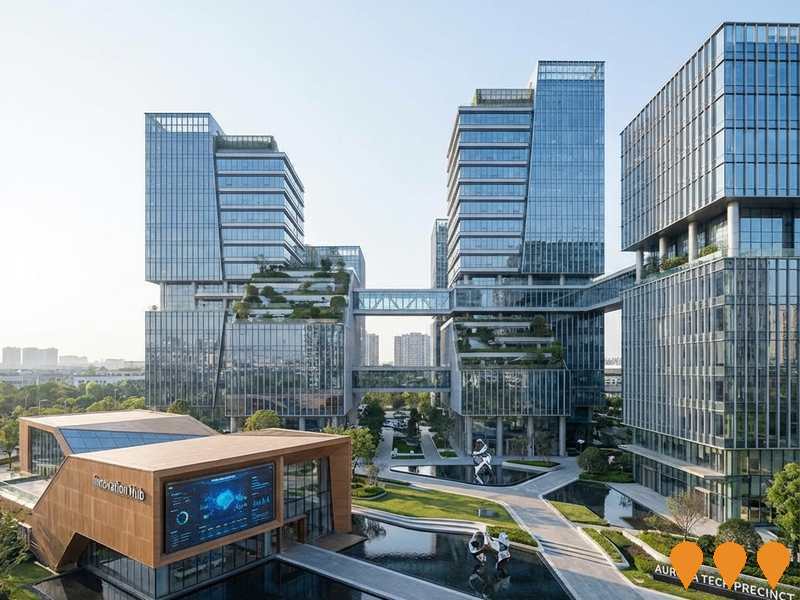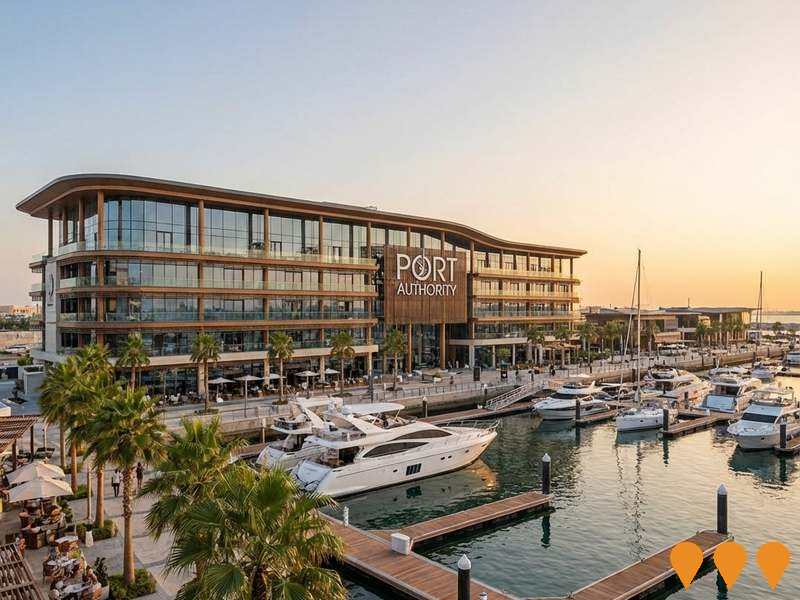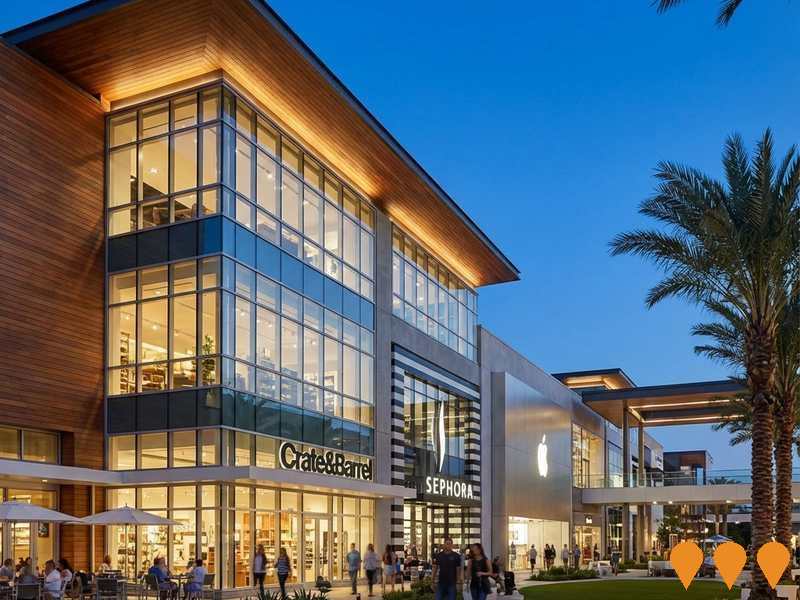Chart Color Schemes
est. as @ -- *
ABS ERP | -- people | --
2021 Census | -- people
Sales Activity
Curious about local property values? Filter the chart to assess the volume and appreciation (including resales) trends and regional comparisons, or scroll to the map below view this information at an individual property level.
Find a Recent Sale
Sales Detail
Population
An assessment of population growth drivers in Millner reveals an overall ranking slightly below national averages considering recent, and medium term trends
Millner's population, as per AreaSearch's analysis, is approximately 2,635 as of August 2025. This figure represents an increase of 59 people since the 2021 Census, which reported a population of 2,576. The change is inferred from the estimated resident population of 2,635 in June 2024 and address validation since the Census date. The population density ratio is 1,792 persons per square kilometer, above the average seen across national locations assessed by AreaSearch. Overseas migration contributed approximately 69.5% of overall population gains during recent periods.
AreaSearch adopts ABS/Geoscience Australia projections for each SA2 area, released in 2024 with a base year of 2022. For areas not covered and post-2032 growth estimation, AreaSearch applies growth rates by age cohort provided by the ABS in its latest Greater Capital Region projections (released in 2023, based on 2022 data). Based on demographic trends, a population increase just below the median of statistical areas across the nation is expected. The area is projected to expand by 322 persons to reach 2,957 by 2041, recording a gain of 12.2% in total over the 17-year period.
Frequently Asked Questions - Population
Development
The level of residential development activity in Millner is very low in comparison to the average area assessed nationally by AreaSearch
Millner has seen approximately one new home approved annually over the past five financial years, totalling eight homes. No approvals have been recorded so far in FY26. The population has fallen during this period, yet development activity has been adequate relative to population change, which is positive for buyers. New properties are constructed at an average expected construction cost value of $750,000, indicating that developers target the premium market segment with higher-end properties.
In FY26, $2.1 million in commercial development approvals have been recorded, suggesting minimal commercial development activity. Compared to Greater Darwin, Millner records significantly lower building activity, 68.0% below the regional average per person. This limited new supply generally supports stronger demand and values for established properties. Nationally, this activity is also below average, reflecting the area's maturity and possible planning constraints. New development consists of 50.0% standalone homes and 50.0% townhouses or apartments, focusing on higher-density living to create more affordable entry points for downsizers, investors, and first-home buyers.
Future projections indicate Millner adding 322 residents by 2041. If current construction levels persist, housing supply may lag population growth, potentially intensifying buyer competition and underpinning price growth.
Frequently Asked Questions - Development
Infrastructure
Millner has limited levels of nearby infrastructure activity, ranking in the 1stth percentile nationally
Changes to local infrastructure significantly impact an area's performance. AreaSearch has identified two projects that may affect this region: Social Housing Accelerator Payment (SHAP) in Greater Darwin/Nightcliff, John Stokes Square Redevelopment, Royal Darwin Hospital Mental Health Inpatient Unit and CSSD Upgrade, Casuarina Square Redevelopment. The following list details those most relevant.
Professional plan users can use the search below to filter and access additional projects.
INFRASTRUCTURE SEARCH
 Denotes AI-based impression for illustrative purposes only, not to be taken as definitive under any circumstances. Please follow links and conduct other investigations from the project's source for actual imagery. Developers and project owners wishing us to use original imagery please Contact Us and we will do so.
Denotes AI-based impression for illustrative purposes only, not to be taken as definitive under any circumstances. Please follow links and conduct other investigations from the project's source for actual imagery. Developers and project owners wishing us to use original imagery please Contact Us and we will do so.
Frequently Asked Questions - Infrastructure
Royal Darwin Hospital Mental Health Inpatient Unit and CSSD Upgrade
New three-storey mental health inpatient facility at Royal Darwin Hospital providing 18 acute inpatient beds plus a 6-bed Stabilisation Assessment and Referral Area (SARA), connected to the Emergency Department via an elevated enclosed walkway. Project also includes major upgrades to the Central Sterile Services Department (CSSD). Managing Contractor: Sitzler Pty Ltd. Works commenced in 2023 with practical completion expected mid-2025.

Australia-Asia PowerLink (AAPowerLink)
The world's largest renewable energy infrastructure project, comprising a 17-20GW solar farm and 36-42GWh battery storage in the Barkly Region, connected via HVDC transmission to Darwin and Singapore. The project received Commonwealth environmental approval in August 2024. It aims to supply up to 4GW of green electricity to Darwin industrial customers and export power to Singapore.

John Stokes Square Redevelopment
The John Stokes Square redevelopment in Nightcliff has transformed an aging public housing estate into a mixed use social housing and community precinct. Delivered by the Northern Territory Government, the project provides a new Nightcliff Police Station, 78 purpose built social housing units for seniors and people living with disability, improved public open space and landscaping, and a pedestrian friendly link between Nightcliff Village and Nightcliff Shopping Centre. Construction of the police station finished in 2021 and the social housing towers were completed in 2023, with tenants now moving in and community housing provider Venture Housing managing the complex.

Enabling Digital Health Services for Regional and Remote Australia
National initiative to expand and improve digital health access for people in regional and remote Australia. Focus areas include enabling telehealth and virtual care, upgrading clinical systems and connectivity, supporting secure information exchange, and building workforce capability in digital health, aligned with the Australian Government's Digital Health Blueprint and Action Plan 2023-2033.

Desert Springs Octopus Renewable Energy Program
Majority Indigenous-owned developer pursuing a near-term pipeline of grid-connected solar and battery projects along the Darwin-Katherine Electricity System, with potential to expand into wind and green hydrogen. Partnership includes Octopus Australia with Larrakia Nation and Jawoyn Association to deliver utility-scale renewable energy and community benefit sharing.

Marine Industry Park
Marine and offshore industries servicing hub at East Arm, Darwin. Stage 1 planning approval is secured for a purpose-built industrial subdivision near the new Darwin Ship Lift, with expressions of interest open for serviced lots. Existing common-user facilities include an all-tide barge ramp (first point of entry) and a secure hardstand supporting storage and fabrication activities.

Hudson Creek Power Station
12MW natural gas-fired power plant, NT's first privately owned grid-connected gas generation facility. Features 25% lower emissions than average NT gas generators. Part of dual project with Batchelor Solar Farm, creating 162 construction jobs and providing vital grid stability to Darwin-Katherine network.

Social Housing Accelerator Payment (SHAP) - Greater Darwin / Nightcliff
Commonwealth-funded SHAP program delivering up to 100 new social and accessible homes across Greater Darwin, Katherine, Tennant Creek and Alice Springs. In Darwin's northern suburbs (including around Nightcliff), the NT Government commenced works in October 2024 with the first eight homes on vacant lots in Rapid Creek, Tiwi and Wanguri. Homes are being built to adaptable standards to better suit local climate and accessibility needs.

Employment
The employment environment in Millner shows above-average strength when compared nationally
Millner has an educated workforce with key services sectors well-represented. As of June 2025, its unemployment rate is 3.2%, with an estimated employment growth of 2.6% over the past year.
In June 2025, there are 1,566 residents employed while the unemployment rate is 0.2% higher than Greater Darwin's rate of 3.0%. The workforce participation rate in Millner is lower at 67.1%, compared to Greater Darwin's 69.7%. Dominant employment sectors among residents include health care & social assistance, public administration & safety, and education & training. Health care & social assistance shows strong specialization with an employment share of 1.5 times the regional level.
Public administration & safety has limited presence at 13.3% compared to the regional average of 19.5%. The area appears to offer limited local employment opportunities based on Census working population vs resident population data. Between June 2024 and June 2025, employment increased by 2.6% while labour force grew by 2.9%, leading to a rise in unemployment of 0.2 percentage points. Greater Darwin recorded employment growth of 2.9% during the same period. Jobs and Skills Australia's national employment forecasts from May 2025 project overall employment growth of 6.6% over five years and 13.7% over ten years. Applying these projections to Millner's employment mix suggests local growth of approximately 6.9% over five years and 14.2% over ten years, though these are simple extrapolations for illustrative purposes and do not account for localized population projections.
Frequently Asked Questions - Employment
Income
Income analysis reveals strong economic positioning, with the area outperforming 60% of locations assessed nationally by AreaSearch
According to AreaSearch's aggregation of the latest postcode level ATO data released for financial year ending June 2022, Millner had a median income among taxpayers of $57,384 with an average income of $66,829. This is slightly above the national average of $65,522 and compares to levels of $65,522 and $75,260 across Greater Darwin respectively. Based on Wage Price Index growth of 12.01% from financial year ending June 2022 to September 2025, current estimates would be approximately $64,276 for median income and $74,855 for average income as of September 2025. Census data reveals personal income ranks at the 74th percentile with a weekly income of $957, while household income sits at the 54th percentile. Distribution data shows that 39.4% of the community (1,038 individuals) earn between $1,500 and $2,999 annually, reflecting patterns seen in the surrounding region where 36.7% similarly occupy this earnings band. High housing costs consume 15.4% of income, though strong earnings still place disposable income at the 56th percentile. The area's SEIFA income ranking places it in the 4th decile.
Frequently Asked Questions - Income
Housing
Millner displays a diverse mix of dwelling types, with above-average rates of outright home ownership
Millner's dwelling structure, as per the latest Census, had 52.5% houses and 47.5% other dwellings (semi-detached, apartments, 'other' dwellings). In comparison, Darwin metro had 68.4% houses and 31.6% other dwellings. Home ownership in Millner was 22.6%, similar to Darwin metro's level. Dwellings were either mortgaged (28.9%) or rented (48.5%). The median monthly mortgage repayment in Millner was $1,733, below Darwin metro's average of $2,028. Median weekly rent in Millner was $340, compared to Darwin metro's $350. Nationally, Millner's mortgage repayments were lower than the Australian average of $1,863, and rents were less than the national figure of $375.
Frequently Asked Questions - Housing
Household Composition
Millner features high concentrations of group households, with a lower-than-average median household size
Family households comprise 64.8% of all households, including 26.9% couples with children, 21.6% couples without children, and 14.3% single parent families. Non-family households make up the remaining 35.2%, with lone person households at 27.3% and group households comprising 8.1%. The median household size is 2.4 people, which is smaller than the Greater Darwin average of 2.7.
Frequently Asked Questions - Households
Local Schools & Education
Educational outcomes in Millner fall within the lower quartile nationally, indicating opportunities for improvement in qualification attainment
In Millner, a significant proportion of residents have achieved higher education qualifications, with 38.7% of those aged 15 and above holding university degrees compared to the Northern Territory average of 27.3% and the national average of 30.4%. This high educational attainment is driven by bachelor degrees (23.2%), postgraduate qualifications (11.8%), and graduate diplomas (3.7%). Vocational education is also prominent, with 29.2% of residents holding trade or technical skills credentials, including advanced diplomas (9.5%) and certificates (19.7%). Educational participation in Millner is notably high, with 33.2% of residents currently enrolled in formal education, comprising 9.8% in primary, 8.5% in tertiary, and 5.9% pursuing secondary education.
Millner Primary School serves the local community with an enrollment of 164 students. The area has varied educational conditions, with one school focusing exclusively on primary education and secondary options available in surrounding areas. Local school capacity is limited, with only 6.2 places per 100 residents compared to the regional average of 16.9, leading many families to travel for schooling.
Frequently Asked Questions - Education
Schools Detail
Nearby Services & Amenities
Transport
Transport servicing is high compared to other areas nationally based on assessment of service frequency, route connectivity and accessibility
The analysis of public transport in Millner shows that there are 16 active transport stops currently operating. These stops serve a mix of bus routes, with a total of 33 individual routes providing service to the area. The combined weekly passenger trips across all these routes amount to 1,774.
The accessibility of transport in Millner is rated as excellent, with residents on average located just 153 meters from their nearest transport stop. On an average day, there are 253 trips made across all routes, which equates to approximately 110 weekly trips per individual stop.
Frequently Asked Questions - Transport
Transport Stops Detail
Health
Millner's residents are extremely healthy with very low prevalence of common health conditions across all age groups
Analysis of health metrics shows strong performance throughout Millner. Prevalence of common health conditions is very low across all age groups.
The rate of private health cover is approximately 52% of the total population (~1,380 people), leading that of the average SA2 area but slightly lower than Greater Darwin's 56.7%. The most prevalent medical conditions are arthritis and mental health issues, affecting 6.5% and 5.7% of residents respectively. A majority, 76.9%, declare themselves completely clear of medical ailments, similar to the 77.0% across Greater Darwin. Millner has 11.8% of residents aged 65 and over (311 people). Health outcomes among seniors are particularly strong, broadly in line with the general population's health profile.
Frequently Asked Questions - Health
Cultural Diversity
Millner is among the most culturally diverse areas in the country based on AreaSearch assessment of a range of language and cultural background related metrics
Millner has a high level of cultural diversity, with 41.7% of its population born overseas and 40.8% speaking a language other than English at home. Christianity is the predominant religion in Millner, accounting for 39.2% of the population. Hinduism is notably overrepresented compared to the Greater Darwin average, comprising 10.5% of Millner's population.
The top three ancestry groups are Other (21.3%), Australian (17.7%), and English (17.7%). Some ethnic groups have notable divergences in representation: Filipino at 5.3%, Spanish at 0.9%, and Greek at 3.9%.
Frequently Asked Questions - Diversity
Age
Millner's population is slightly younger than the national pattern
Millner's median age is 36, slightly higher than Greater Darwin's 34 but lower than Australia's 38. Compared to Greater Darwin, Millner has a higher percentage of residents aged 55-64 (13.5%) but fewer residents aged 15-24 (9.6%). Between the 2021 Census and present, the 55 to 64 age group grew from 10.8% to 13.5%, while the 35 to 44 cohort increased from 15.3% to 16.8%. Conversely, the 45 to 54 cohort declined from 13.8% to 10.7%, and the 65 to 74 group dropped from 8.0% to 6.5%. By 2041, population forecasts indicate significant demographic shifts in Millner. The 35 to 44 age group is projected to grow by 16%, adding 69 residents to reach a total of 512. Meanwhile, the 0 to 4 age group is expected to grow by a modest 4% (an increase of 5 people).





